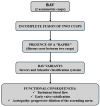Bicuspid Aortic Valve and Sudden Cardiac Death
- PMID: 40566523
- PMCID: PMC12194644
- DOI: 10.3390/life15060868
Bicuspid Aortic Valve and Sudden Cardiac Death
Abstract
Bicuspid aortic valve (BAV) is the most common congenital heart anomaly, affecting an estimated 0.5% to 0.77% of the general population. This condition occurs when the aortic valve has only two cusps instead of the usual three, disrupting normal valve function and increasing the risk of various cardiovascular diseases. Often asymptomatic in its early stages, BAV can gradually progress, leading to stenosis, valve insufficiency, and abnormalities of the ascending aorta. One particularly concerning aspect is its potential association with sudden cardiac death (SCD). The aim of this literature review is to examine the relationship between BAV and the risk of SCD, highlighting the pathogenic variants and pathophysiological mechanisms involved while emphasizing the significance of valve classification and its clinical implications. Additionally, it explores current research gaps and future directions to enhance early identification of at-risk individuals and reduce the incidence of SCD.
Keywords: bicuspid aortic valve; cardiovascular complications; classification valvular; pathogenic variants; preventive strategies; sudden cardiac death.
Conflict of interest statement
The authors declare no conflicts of interest.
Figures
Similar articles
-
Outcomes of valve-sparing aortic root replacement in patients with bicuspid aortic valve and tricuspid aortic valve: a systematic review and meta-analysis.J Cardiothorac Surg. 2023 Jul 3;18(1):206. doi: 10.1186/s13019-023-02329-8. J Cardiothorac Surg. 2023. PMID: 37400892 Free PMC article.
-
Unicuspid aortic valve in children: a systematic review spanning four decades.J Heart Valve Dis. 2010 Nov;19(6):678-83. J Heart Valve Dis. 2010. PMID: 21214089
-
Bicuspid aortic valve morphology and its impact on aortic diameters-A systematic review with meta-analysis and meta-regression.Echocardiography. 2018 May;35(5):667-677. doi: 10.1111/echo.13818. Epub 2018 Feb 4. Echocardiography. 2018. PMID: 29399873
-
Comparing outcomes after transcatheter aortic valve replacement in patients with stenotic bicuspid and tricuspid aortic valve: A systematic review and meta-analysis.Clin Cardiol. 2018 Jul;41(7):896-902. doi: 10.1002/clc.22992. Epub 2018 Jul 18. Clin Cardiol. 2018. PMID: 29896777 Free PMC article.
-
The Duke minor criterion "predisposing heart condition" in native valve infective endocarditis - a systematic review.Swiss Med Wkly. 2018 Nov 15;148:w14675. doi: 10.4414/smw.2018.14675. eCollection 2018 Nov 5. Swiss Med Wkly. 2018. PMID: 30440064
References
-
- Mubarik A., Sharma S., Law M.A. StatPearls. StatPearls Publishing; Tampa, FL, USA: 2023. Bicuspid Aortic Valve. - PubMed
-
- Kalra A., Das R., Alkhalil M., Dykun I., Candreva A., Jarral O., Rehman S.M., Majmundar M., Patel K.N., Rodes-Cabau J., et al. Bicuspid Aortic Valve Disease: Classifications, Treatments, and Emerging Transcatheter Paradigms. Struct. Heart. 2023;8:100227. doi: 10.1016/j.shj.2023.100227. - DOI - PMC - PubMed
-
- Sillesen A.S., Vøgg O., Pihl C., Raja A.A., Sundberg K., Vedel C., Zingenberg H., Jørgensen F.S., Vejlstrup N., Iversen K., et al. Prevalence of Bicuspid Aortic Valve and Associated Aortopathy in Newborns in Copenhagen, Denmark. J. Am. Med. Assoc. 2021;325:561–567. doi: 10.1001/jama.2020.27205. - DOI - PMC - PubMed
Publication types
LinkOut - more resources
Full Text Sources




